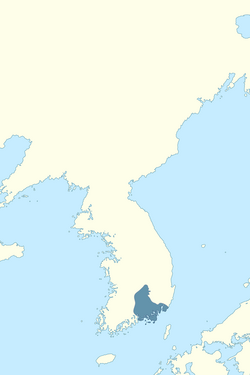
Back كونفدرالية غايا Arabic Kaya konfederasiyası Azerbaijani قایا کونفدراسیاسی AZB Gaya Catalan یەکێتیی گایا CKB Kaja (kmenový svaz) Czech Gaya (føderation) Danish Gaya German Confederación Gaya Spanish کنفدراسیون گایا Persian
Gaya confederacy 가야 (加倻) | |||||||||||
|---|---|---|---|---|---|---|---|---|---|---|---|
| 42–562 | |||||||||||
 Map showing the approximate location of selected Gaya polities. | |||||||||||
| Common languages | Gaya | ||||||||||
| Religion | Buddhism, Shamanism | ||||||||||
| Government | Confederacy | ||||||||||
• 42–199 | Suro (first, Geumgwan) | ||||||||||
• ?-562 | Doseolji (last, Dae) | ||||||||||
| Historical era | Ancient | ||||||||||
• Establishment | 42 | ||||||||||
• Submission to Silla | 562 | ||||||||||
| |||||||||||
| Today part of | South Korea | ||||||||||
| Gaya confederacy | |
 Duck-shaped pottery from Gaya, 5th or 6th century. | |
| Korean name | |
|---|---|
| Hangul | 가야 |
| Hanja | |
| Revised Romanization | Gaya |
| McCune–Reischauer | Kaya |
| History of Korea |
|---|
 |
| Timeline |
|
|
Gaya (Korean: 가야; Hanja: 加倻; RR: Gaya, Korean pronunciation: [ka.ja]) was a Korean confederacy of territorial polities in the Nakdong River basin of southern Korea,[1] growing out of the Byeonhan confederacy of the Samhan period.
The traditional period used by historians for Gaya chronology is AD 42–532. According to archaeological evidence in the third and fourth centuries some of the city-states of Byeonhan evolved into the Gaya confederacy, which was later annexed by Silla, one of the Three Kingdoms of Korea. The individual polities that made up the Gaya confederacy have been characterized as small city-states.[2] The material culture remains of Gaya culture mainly consist of burials and their contents of mortuary goods that have been excavated by archaeologists. Archaeologists interpret mounded burial cemeteries of the late third and early fourth centuries such as Daeseong-dong in Gimhae and Bokcheon-dong in Busan as the royal burial grounds of Gaya polities.[3]
© MMXXIII Rich X Search. We shall prevail. All rights reserved. Rich X Search